
Cryptosiphonia woodii
Dark Branched-tube Seaweed, Bleached Brunette
Observations & interactions: February 10 & 13, 2022.
Gonzales Bay, Juan de Fuca strait, B.C., Canada.
Tide: receding from 4.9ft at 3pm to 3.9ft at 4pm (10 Feb 2022) (measured at Oak Bay Tidal Station)
and
Tide: receding from 5.9ft at 4pm to 4.6ft at 5pm (13 Feb 2022) (measured at Oak Bay Tidal Station)
Conditions (13 Feb 2022): Mostly cloudy, wind light and variable, sea rippled, humidity 70%, 8˚C.
Moon: Waxing Gibbous (92%, day 13, 13 Feb 2022 & 96.5%, day 14, 14 Feb 2022); Previous Phase, First Quarter, 8 Feb 2022 at 5:50am PST: Next Phase, Full Moon, 16 Feb 2022 at 8:56am PST.
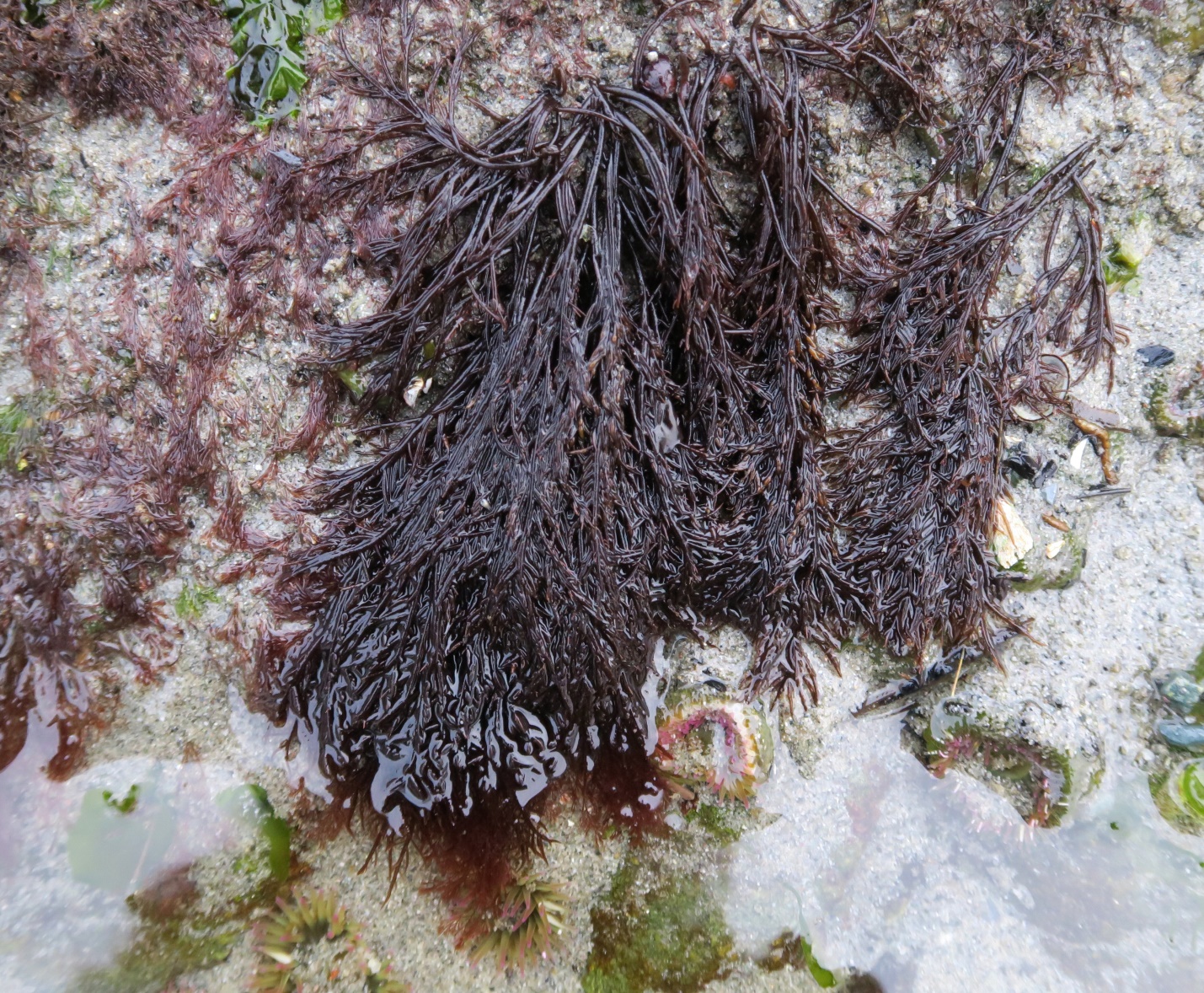
Figure 1: The darker ‘red’ colored and more physically ‘substantial’ seaweed (length of longest thallus is 15cm) in the photo above is Cryptosiphonia woodii. Its holdfast is affixed to the bedrock outcropping here and the surrounding substrate is ‘washed’ over in a coating of sand from the adjacent beach. Gonzales Bay, Juan de Fuca Strait, B.C., Canada. February 10, 2022. Photo ID 27386 ©Seaweedwhisperings.com
Person 1:
We’ve seen this seaweed in several locations over the past year. The first one I recall is from Gonzales Bay prior to March 2021. The other location of note was Point Holmes.
I seem to want to be particular about locations. Does this seaweed need to know its place in society to be comfortable?
We observed this seaweed in its environment yesterday near sunset; the beach was noisy and filled with noxious creosote wood smoke and I could not ground and settle to record my observations on site. The following notes are from last night & earlier this morning:
It’s dark in appearance. Living in the high mid-intertidal zone, I wonder if it wants the dark color to help absorb more light… it has a very short submersion period to be active.
Smooth and shiny. The shine is what captures my attention, detracting / distracting me from exploring the details of its energy. Is this an armor of sorts?
Thrives early in the growing season. There must be a balance (with the dark coloration) between desiccation and absorption. There is less heat and UV radiation early in the season, so that’s when it can thrive… sure looks prime in February and March.

Figure 2: A closer view of the stems of Dark Branched-tube Seaweed. The ‘shining’ thalli are growing alongside other smaller branched red seaweeds and are resting atop the retracted green form of an invertebrate, Anthopleura elegantissima. Gonzales Bay, Juan de Fuca Strait, B.C., Canada. February 7, 2021. Photo ID 27387 ©Seaweedwhisperings.com
Now, to continue with my current reflections:
I get a sense that it is showy, but doesn’t do much most of the time. Being high to mid intertidal, it is out of water for extended periods, thus can just laze around most of the day.
I sense an essence of spurts of energy, but with little persistence, possibly even predisposed to “failure”. But failure is not a problem for this seaweed… it’s, “Oh well, that didn’t work. I think I’ll take a nap, or have a beer. Maybe I’ll think of something new.”
Could be a pioneer / inventor, eager to explore.
Could be an “early adopter”, eager to try out the latest technology or innovation.
Holdfast is almost impossible to see. It’s buried beneath the substrate or under sea creatures (particularly anemones). Does this seaweed hold many secrets, so deeply buried that others don’t even suspect there are secrets? I wonder if even Cryptosiphonia is unaware. Maybe it’s just living a fantasy “knight-in-shining-armor” life. They are comfortable in their place, happy and simple. Others may just see the shiny surface and a type of naïveté.
Cryptosiphonia is not tidy and organized. Its tube-like stems are of different diameters and not in perfect tube shapes. Its branches are irregular, not noticeably alternate or opposite…, they seem almost random in pattern.
Out of water Cryptosiphonia appears very comfortably flopped over the substrate. Because it has a relatively dense structure, it likely retains quite a bit of moisture and doesn’t desiccate easily. So it’s “ready to go” when the seawater returns.
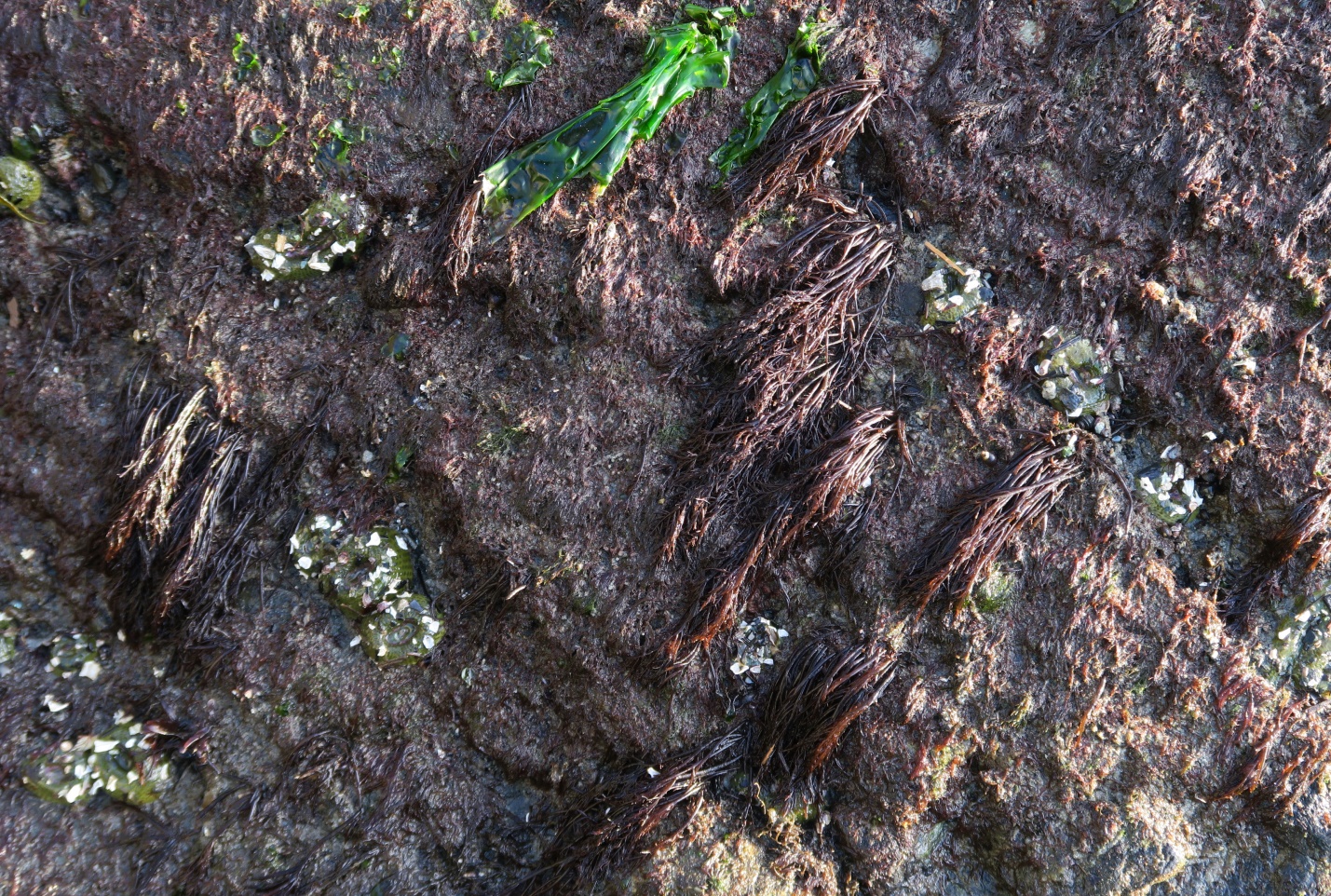
Figure 3: On this bedrock that reaches into the waters of Gonzales Bay several deep maroon-colored ‘tufts’ of Cryptosiphonia woodii are growing. Exposed at only a moderately low tide the thalli drape downward from their holdfasts. Gonzales Bay, Juan de Fuca Strait, B.C., Canada. February 7, 2021. Photo ID 27388 ©Seaweedwhisperings.com
Person 2:
Recently I’ve been seeing you again at Gonzales Bay. Looking fresh and strong. Dark, dark red, purplish, almost black stems. Draped over the bedrock of the bay and visible at low tide.
Draping, hanging down with graceful curves, but always down – like you cannot defy gravity. You must succumb to forces, you choose to go with them, see no point in trying to be strong enough to resist.
Go with… (a stronger force), yes, AND “go with” gracefully and with a fluid kind of style. Watching you as the tide was receding I felt that the movement of your branches with the flow of the ocean swell was almost ‘balletic’. Your main stems would ‘flow with’ and your smaller side branchlets would move along but with a bit of a delayed timing, like a ballerina flipping the tips of her fingers at the completion of a graceful sweep of her arms. You have a ‘style’ to your going with, a way to ‘shine’ as you move.
In water you are built such that your branches and branchlets float away from each other as if seeking the maximum possible space between each of your parts. This is a very different look than the out of water one.
On the rocks, too, individual ‘plants’ seem to grow with space between them. They do not crowd in together such as Fucus will do. It is as if you avoid being “too close”.
Each individual has multiple main stems that arise from a very well-hidden holdfast. These stems, when immersed, radiate out in all directions. Branchlets start to appear about halfway up the tubular stems, growing in an irregular pattern radiating from the main stems. The branchlets are not flattened into one plane; instead they take advantage – of all 360 degrees of positioning that is possible around the tubular thallus. In this way, too, it seems that you are occupying space fully for yourself. Your space is important to you and you don’t want others intruding in it.
I noted also that in documenting our Whispering impressions, when Person 1 chose his chair, I then adjusted where I would sit so that we had quite a large space between us. Anything closer did not feel right.
While writing my notes, I got up for a glass of water and while coming back to my chair I stubbed the toes of one foot. This reminded me that I stubbed my toes on the steps yesterday just after coming from the beach after observing Cryptosiphonia in situ. I am not usually clumsy with my feet in this way, in fact I can’t recall the last time I stubbed my toes. Is this a reason why Cryptosiphonia wants lots of space? Is it not quite in control of its own movements and intuitively seeks enough space so it does not “bash” into things / others?
The dark purplish, reddish black color of this seaweed is reminiscent of freshly and deeply bruised human flesh. Does this seaweed have a ‘nature’ that easily bruises? Physically, this may be so and emotionally I sense definitely, YES!! The way in which I’ve been “easily offended” in the past days since first connecting with this seaweed on February 10th is notable. “Offended” meaning that in interactions with others, including very close relationships, I’ve felt a ‘rough’ or inconsiderate kind of handling. In communications I’ve noted that I felt not valued, criticized unfairly and knocked around by their opinions. In some interactions I’ve even felt as if verbally “toyed with” and this has “hurt” me emotionally, when at other times this kind of thing would usually not impact me deeply or I could at least meet it with a sense of humor. I had NO humor to draw from these past few days. Things cut deeply. It has been as if my sensitivity to being NOT acceptable and even, damn it, to being NOT lovable just the way I am, was turned way up.
So I felt hurt emotionally and that hurt turned quickly to resentment that was tinged with injustice and incredulity. From there the desire was to distance myself – to put a certain amount of physical space between myself and the “offending party”; all this in aid of shutting down the likelihood of more ‘offences’ occurring.
Communications seemed particularly difficult, too. For example, in conversation with Person 1 I found him to be unwilling to answer me unless I managed to phrase my question in just the right way. It felt to me as if he wasn’t able, or worse, was unwilling to “step in” to the general intent of my question and contribute. It felt like I needed to provide the “specific entry point” that worked for him, and with every time that I would fail to find it after having rephrased my question yet again, I became more and more frustrated and disappointed. It felt as if I had to “guide the thread” right up to the head of the needle before he would say anything about what I was asking. This proved so difficult to keep trying for that it provoked in me the response to simply give up trying to communicate, so once again, to shut down.
Communication was also “not working” in a very much less personal way in that almost from the first time last week when I saw the lovely Cryptosiphonia woodii algae doing so well down at the bay and contemplated, “is this the time to do a Whispering?”…, almost since that moment our Internet Service Provider has been “down”. The service they use for their DSL lines continued to be ‘not functioning and under repair’ for a full three days – this is the longest continuous disruption in service we’ve ever experienced. It certainly made our “normal modes of communication” totally shut down and unavailable to us.
This internet outage affected customers of our ISP in our province and in the neighboring one. It affected a large number of people in our country and seemed to have been a rather difficult problem to solve given the length of time the system was under repair. I had the thought – does the energy of this seaweed proactively shut down the ‘external world’ and demand “look at me!” Or is this seaweed one that has an energy type that is incompatible with ‘high tech’ devices and communication? Is it one that prefers a face to face conversation, a slower world where one looks up definitions of words in a dictionary that is a printed book, not a google search? Does this seaweed intuitively ‘feel’ the gaps in their experiential existence that are created by reliance on these high tech connections? Is it so unhappy with high tech mediums that their energy can shut it down and render it inoperable for them?
I pondered how I felt to be without internet connection for so many days. It was interesting and complex.
I could say, hey, this is like a “snow day” – I can’t work as normal so let’s take “time out to play”. But increasingly I felt a kind of pressure from the accumulating backlog of tasks that ultimately were going to need my attention.
I also felt “cut off” from my usual access to touchstones like daily information on the weather, tides, and regular messages in and out.
I felt “stalled” in researching things I would have done quickly if I’d had operating internet. Of course, I could physically go to another location and use their internet access – a library a coffee shop, etcetera, but this required extra travel time and was noisy, inconvenient and lacked privacy.
I felt “alone” and somewhat isolated when the situation continued, alone in that there was no “comfort” arriving via the usual input I receive from others via email or video conferencing. I could only rely on that which was directly physically available to me or that which I could energetically discern for myself without the aid of high tech connections.
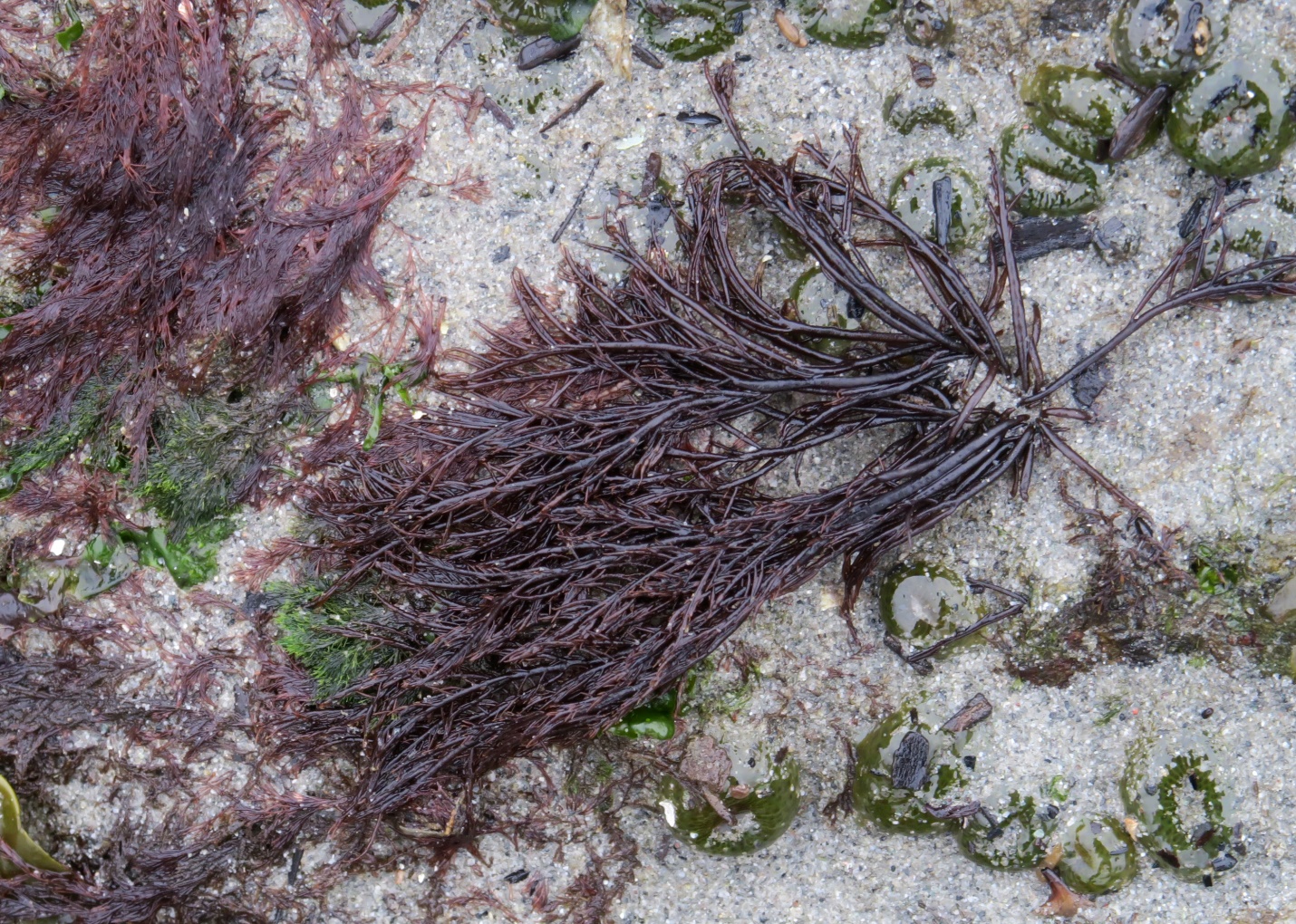
Figure 4: This photo shows a typical community where Cryptosiphonia woodii thrives. It is anchored on a bedrock protrusion, but the area is also washed with sand. Many small pink-tipped surf anemones (seen here as greenish doughnut shapes with tentacles retracted until the return of the tide) dot the area. Growing nearby are other macro algae including Ulva lactuca and Polysiphonia pacifica and Fucus distichus. Gonzales Bay, Juan de Fuca Strait, B.C., Canada. February 10, 2022. Photo ID 27389 ©Seaweedwhisperings.com
Person 2 - a few days later:
I was sitting in the early morning admiring the almost totally full moon and I recalled the weariness that both Person 1 and I felt when in the midst of experiencing recent emotional upsets and communication difficulties. Person 1 had said to me yesterday “it will be nice when we can have an ‘approach of exploration’ once again when we have that kind of difficulty.” I said, “yes, and to have access to that in the midst of the difficulty – that’s what we were lacking earlier in this Whispering”.
I pondered what it was in my experience of this seaweed’s energy that had that exploratory attitude so far from possible for me and I recognize now that it was the feeling of having to do it by myself. This seaweed does not want to have to do things alone. It wants the company and the willing cooperation of others in whatever it is up to. It doesn’t necessarily want its hand held all the time, but it wants to know it is not alone in it. I also think this seaweed doesn’t care all that much that they get it right, but it does care very much that there is a “they”, a “group”, or at very least an “other” involved in it with them. This feels right and good and safe and comfortable to them. When that is in place then this seaweed can venture into difficult ‘terrain’ with confidence, can extend themselves beyond their singular personal limitations, can creatively contribute and can find its answers together with others.
I thought again about the morphology of this seaweed. There are clusters of main thalli that grow in a grouping which some phycologists call “tufts”. A larger cluster may have easily eight or a dozen or sixteen thalli arising from the holdfast, younger plants have only two or four. As earlier noted, it seems that each of these ‘tufts’ prefers to have some space between itself and the next tuft of Cryptosiphonia woodii. The concept arises that it feels like one tuft is a “family unit” and that Cryptosiphonia is very strongly identified with its family, happiest amongst its family, and will in fact keep distance from everyone else who is also Cryptosiphonia but not a member of its own family unit. This feels like a good approximation of human social structure imposed upon the macro algal world.
So, “together”, for Cryptosiphonia, is ideally with others of its own family unit. And when that condition is met, then the Cryptosiphonia individual can contemplate the world beyond their family…, observing, exploring, and maybe even trying out how other people do things. But it is very perplexing to this seaweed to accept differences in others that strongly contradict the values and norms of their own family group. This is difficult to understand and is especially hard to acknowledge when it leads to competition, conflict, aggression, and so on.
Peaceful respect is desired.
Acceptance would be very nice.
Open hearted tolerance and understanding would be ideal.
“United we stand, divided we fall” – this expression fits this seaweed very well. As a group they can be at their fullest cooperative and creative power, but the easiest way to undermine them is to separate them and force them to live or act alone and out of contact with their ‘group’.
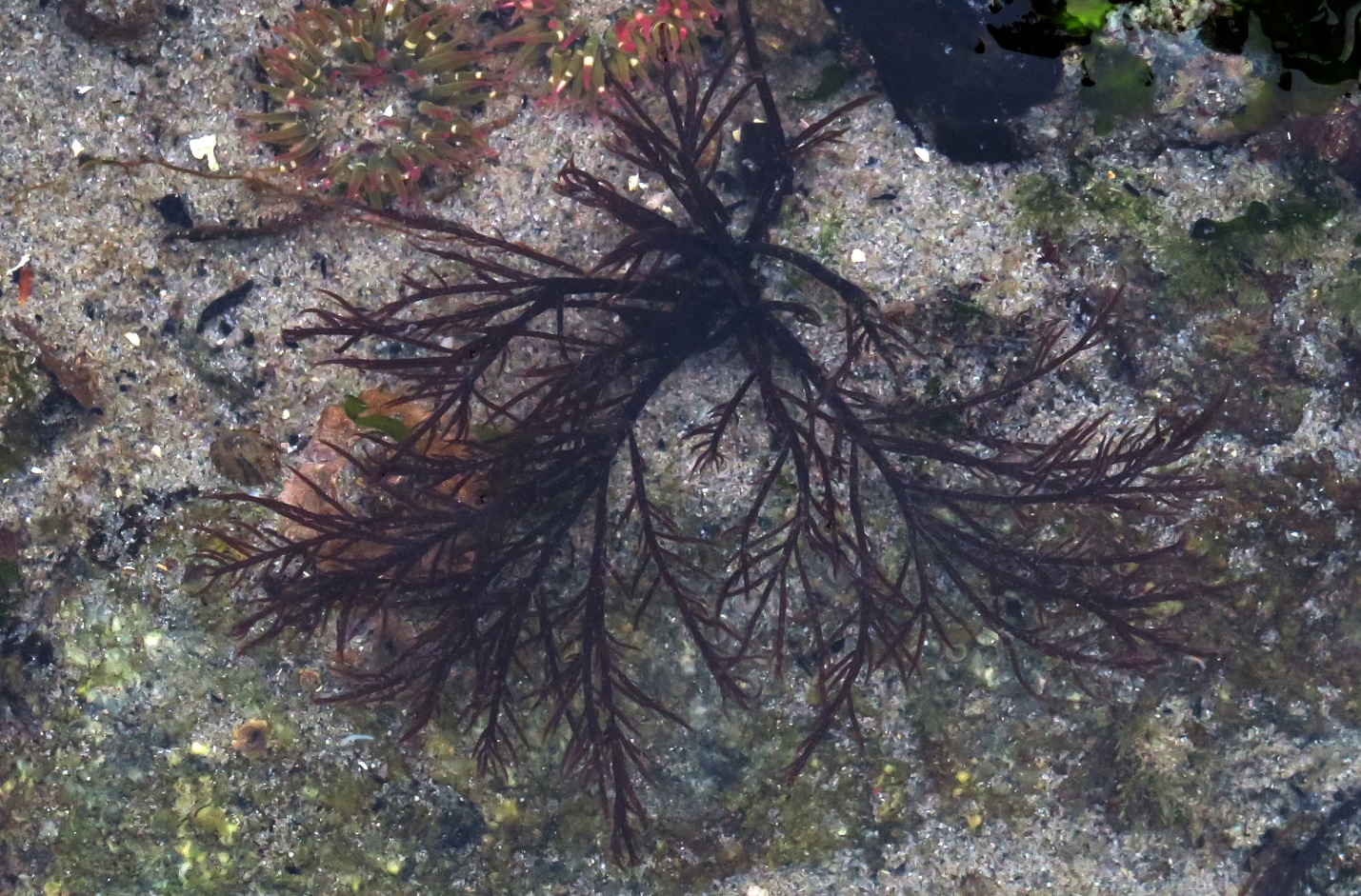
Figure 5: Pictured here is a single, modest sized Cryptosiphonia woodii spread out as it prefers to when submerged. Gonzales Bay, Juan de Fuca Strait, B.C., Canada. February 13, 2022. Photo ID 27390 ©Seaweedwhisperings.com
Biology & Natural History Information:
Description:
Cryptosiphonia woodii is one of the numerous profusely branched red algae that are abundant in our region. It is not hard to distinguish once you get to know it as it is a peculiar dark olive brown to deep maroon color, rather than the more typical rosy red or purplish red of most other similar red alga. Late in the season, the tips of the branches tend to lighten in color considerably, leading to the common name, Bleached Brunette. By comparison Cryptosiphonia is also coarser in size and also grows higher on the rocks than most other multi-branching reds. By late April the densely tufted thalli have reached between 10 cm and 25 cm tall and become reproductive. Males and females are separate individuals in this species. The branching pattern can help distinguish this seaweed as the irregular radial branching begins about halfway up the main axis; this leaves a distinctive unbranched segment to the algae. Lower branches are longer than the more distal ones and all branches are tapered both at their bases and tips. Side branching occurs, with the same morphology and side branches themselves also bear short branches. Thallus is attached to the substrate by a small discoidal holdfast.
Habitat:
This annual red alga grows in dense tufts and is found on rock in the mid- intertidal zone of protected to semi-exposed habitats. Researchers believe that Bleached Brunette is an opportunistic species that is able to rapidly colonize new space that may open up in the intertidal zone at a suitable height.
North Pacific Distribution:
Unalaska Island, Alaska to San Pedro, California.
Remarks:
Researchers have found polysaccharide extracts from Cryptosiphonia woodii that are useful in treatment of Herpes simplex virus in humans. Constantinea and Farlowia species are also being tested for similar purposes. This is the type species (lectotype) of the genus Cryptosiphonia. Type location is Vancouver Island, British Columbia, Canada.
Former name(s): Pikea woodii (J.Agardh) 1872, Cryptosiphonia grayana (J.Agardh)
Classification:
Phylum: Rhodophyta
Class: Florideophyceae
Order: Gigartinales
Family: Dumontiaceae
Genus: Cryptosiphonia
Species: Cyptosiphonia woodii (J.Agardh) J.Agardh 1876
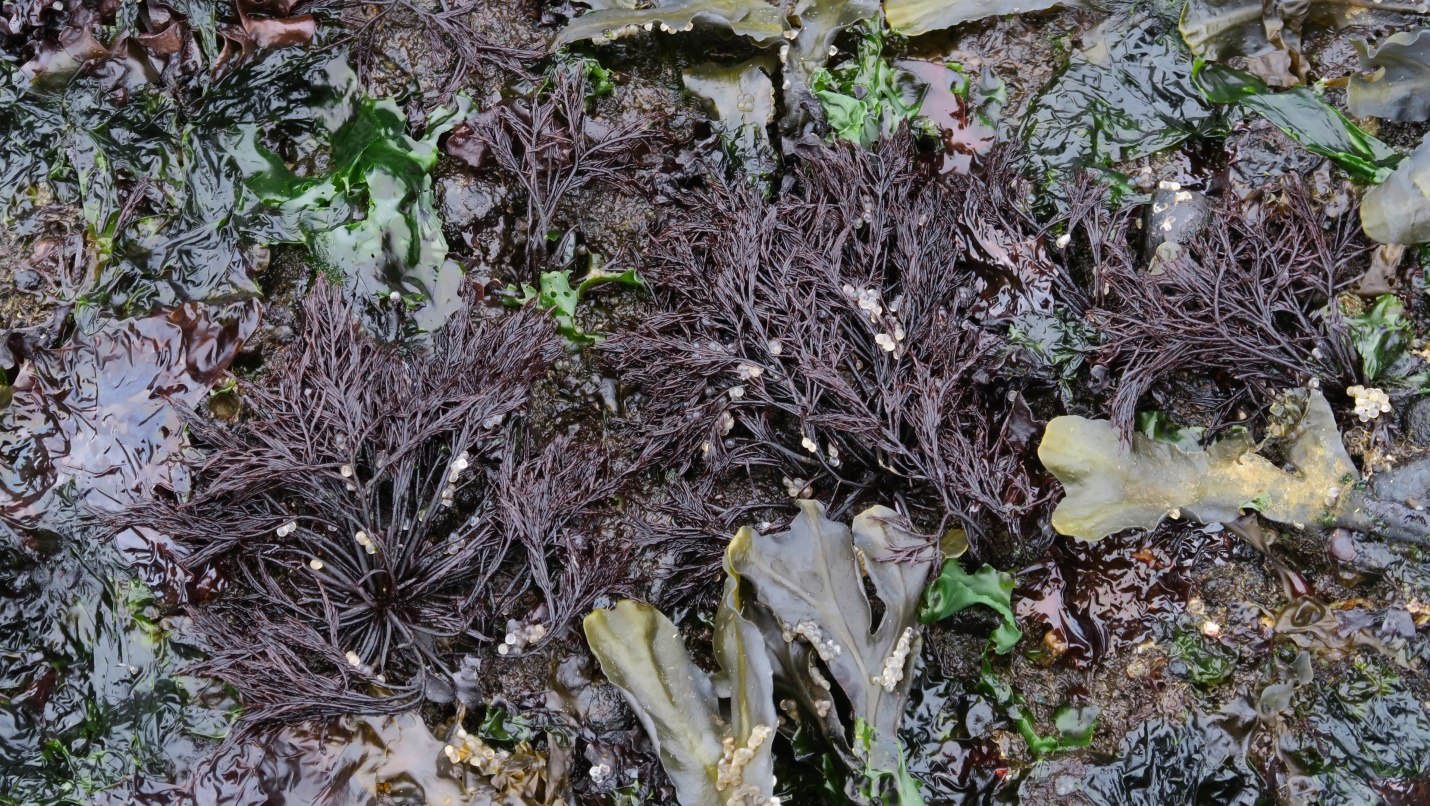
Figure 6: Pictured here is a collection of macro algae as they look in mid-March. The Fucus blades and the stems of Cryptosiphonia woodii are holding herring eggs – the spawn occurs annually around this time. Point Holmes, Strait of Georgia, B.C., Canada. March 20, 2021. Photo ID 27391 ©Seaweedwhisperings.com
![]()